In the field of industrial valves and piping systems, butterfly valves are one of the most effective and cost-saving solutions for water supply and drainage systems, fire protection, HVAC, chemicals, or wastewater treatment. With their compact design, flexible operation, and reasonable cost, butterfly valves are gradually becoming the top choice to replace gate valves or ball valves in many large and small projects.
If you’re looking to understand what a butterfly valve is, its structure, how it operates, and how to choose the right type of butterfly valve for your system, this article is everything you need. Let’s explore in detail the most popular industrial valve series today with Bao Tin Steel.
What is a butterfly valve?
A butterfly valve is an industrial valve that operates by rotating 90 degrees, primarily used to control the flow of liquids, compressed gases, or powdered materials in piping systems.
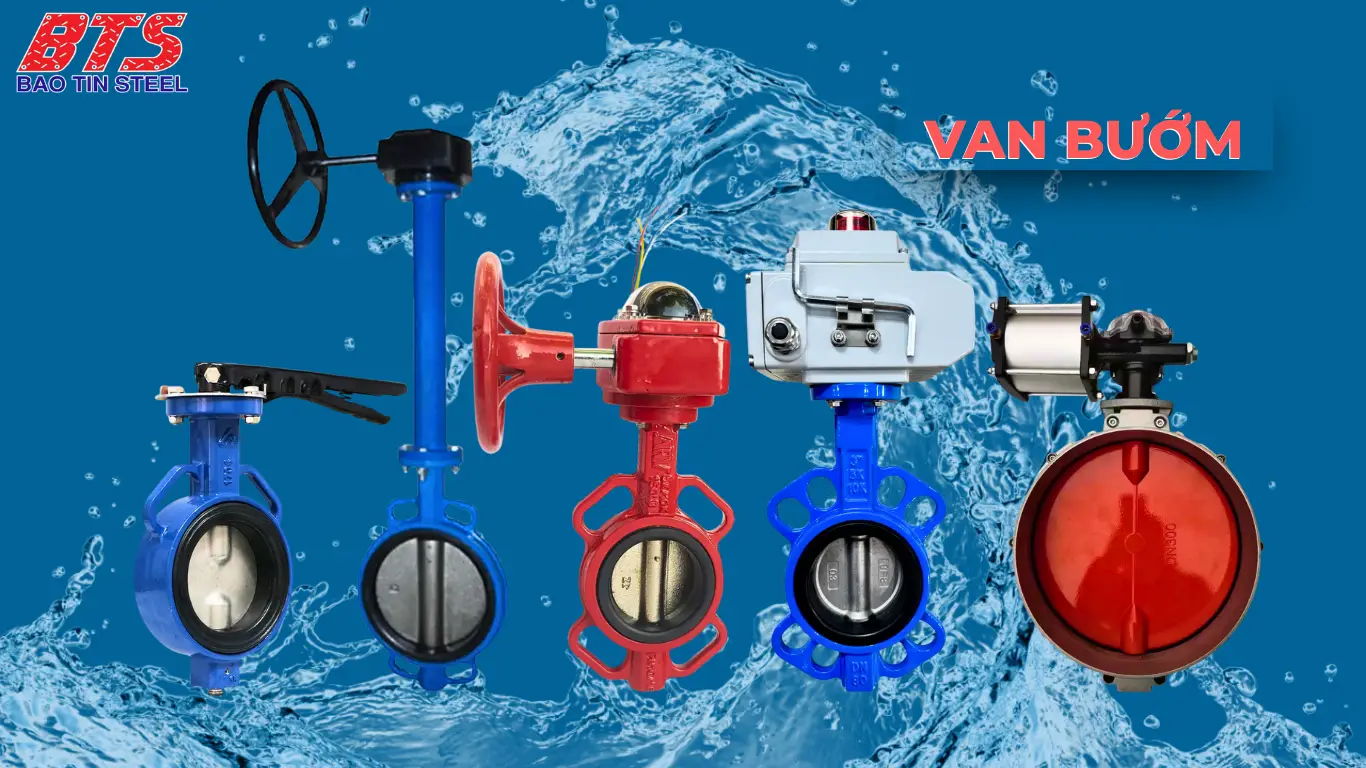
The valve operates based on a round disc (known as the butterfly) mounted on a rotating shaft, allowing the flow to be adjusted from fully open, fully closed, to intermediate flow regulation.
The name “butterfly valve” comes from the valve’s appearance when viewed from the front— the open disc resembles butterfly wings, while the shaft and lever are likened to the body and antennae of a butterfly. This design is not only easy to visualise but also helps save installation space compared to traditional valves like gate or ball valves.
Outstanding advantages:
- Compact Design, Ideal for Limited Spaces: The compact nature of butterfly valves makes them perfect for installations in confined or restricted spaces.
- Quick Operation: With just a 90-degree (1/4 turn) rotation, these valves can open and close quickly, ensuring efficient control of flow.
- Cost-Effective: Butterfly valves offer an economical solution, making them suitable for both residential and industrial systems, providing excellent value for money.
- Flexible Flow Regulation: Particularly effective in large pipelines, butterfly valves allow precise flow regulation, making them versatile and highly adaptable in various system applications.
With the features mentioned above, butterfly valves are considered the optimal choice for many industries, such as water treatment, fire protection (PCCC), oil and gas, chemicals, food processing, HVAC, and more.
Butterfly valve structure
A standard butterfly valve consists of 5 main components, working harmoniously to perform the functions of opening, closing, and regulating flow effectively. Depending on the type of valve and its intended use, it may include additional electric or pneumatic actuators, but fundamentally, it revolves around the following components:
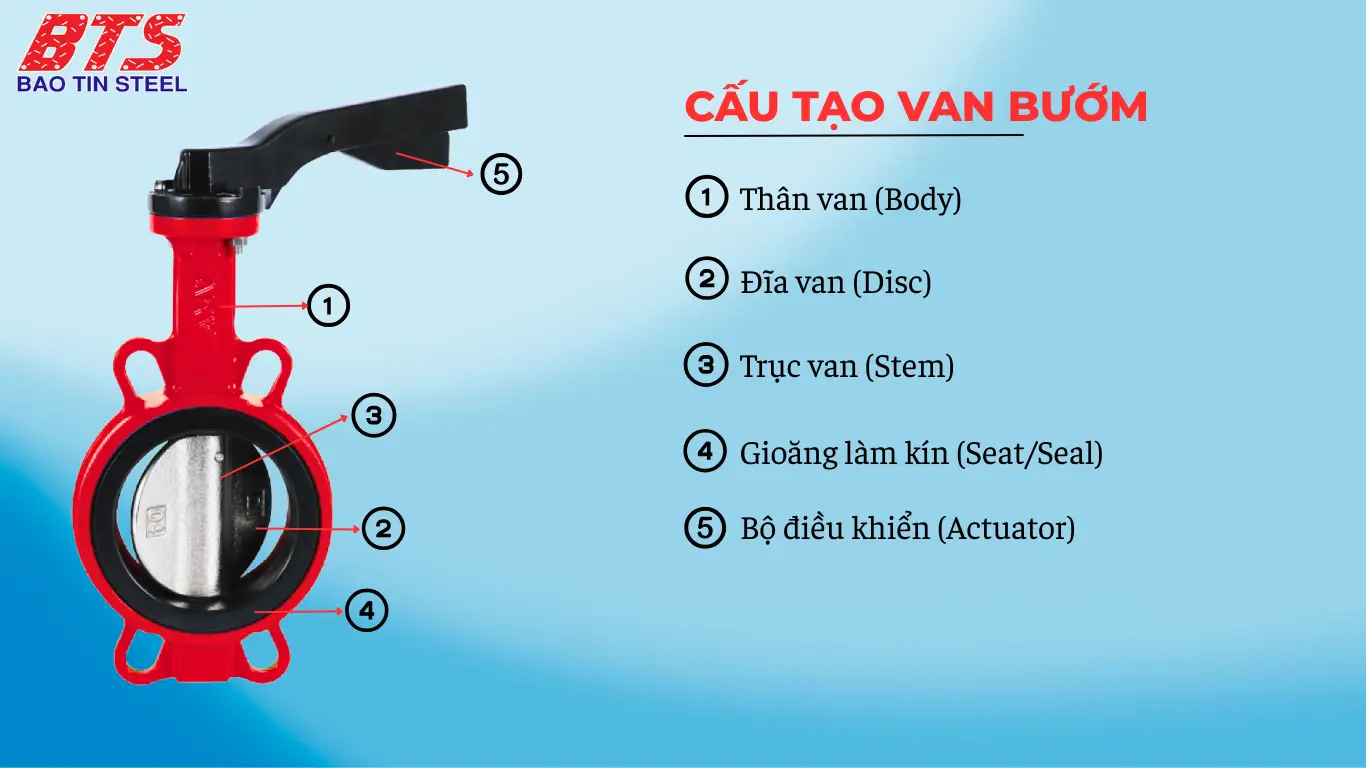
1. Body
It is the main frame that encloses and shapes the entire valve. The valve body is typically cast as a single piece using materials such as cast iron, ductile iron, stainless steel, carbon steel, or engineering plastics. The design can be wafer, lug, flanged, or welded, suitable for a variety of pipe connection types.
2. Disc
Also known as the “butterfly”, this component directly regulates the flow. When the disc is rotated perpendicular to the flow, the valve closes; when rotated parallel, the valve is fully open. The disc is usually made from stainless steel, coated cast iron, epoxy-coated steel, or plastic, and can be designed as concentric or eccentric to meet the required pressure and sealing specifications.
3. Stem
It is the power transmission shaft connecting the lever (or actuator) to the valve disc. The shaft is typically made of stainless steel or hardened alloy steel and can be either a wet shaft (in contact with the fluid) or a dry shaft, depending on the operating environment.
4. Seat/Seal
The gasket’s role is to create a seal between the disc and the valve body, preventing leakage of the fluid. Common materials include EPDM rubber, NBR, Teflon (PTFE), or elastomeric metals. Choosing the correct type of gasket is crucial for determining the valve’s durability, pressure resistance, and chemical compatibility.
5. Actuator
- Lever: used for small DN valves, simple operation
- Handwheel: supports smooth opening/closing of large valves
- Electric or pneumatic controller: used for automatic systems, requiring remote control, precision and continuity
Note: The construction of the butterfly valve directly affects its lifespan and operational performance. Therefore, selecting the right materials, connection types, and control methods is crucial during the system design process.
Butterfly valve operating principle

A butterfly valve operates by rotating the valve disc 90 degrees around a fixed shaft to control the open, closed, or flow-regulating state in the pipeline. It is a type of quarter-turn valve, offering fast and intuitive operation.
When the valve disc is parallel to the flow direction, the valve is fully open, allowing the fluid to pass through with minimal resistance. On the other hand, when the disc rotates perpendicular to the flow, it blocks the entire cross-section of the pipe, shutting off the flow. In addition to these two extreme positions, the valve disc can also be fixed at various angles, providing precise flow regulation.
Basic operating states:
| Valve State | Disc Rotation Angle | Flow Condition |
|---|---|---|
| Fully Open | ~0° | Maximum flow |
| Flow Regulation | ~15°–75° | Adjustable flow |
| Fully Closed | ~90° | Flow blocked |
Advantages in operation:
- Fast Operation, Minimal Effort: Especially when using a lever or electric actuator, butterfly valves require little force to operate, making them efficient for quick adjustments.
- Precise Feedback: Suitable for both instant on/off operations and continuous flow regulation, providing accurate control.
- Low Wear and Tear: Particularly when using an eccentric design to reduce sliding contact between the disc and the gasket, butterfly valves experience less wear over time, enhancing durability.
Common types of butterfly valves
Butterfly valves on the market today are very diverse, classified based on many criteria such as: manufacturing materials, connection types, control methods and valve disc design. Each type has characteristics suitable for the usage environment and specific technical requirements.
Classification by material
Choosing the right material helps increase the longevity and stability of the system. Here are some common materials used to make butterfly valves:
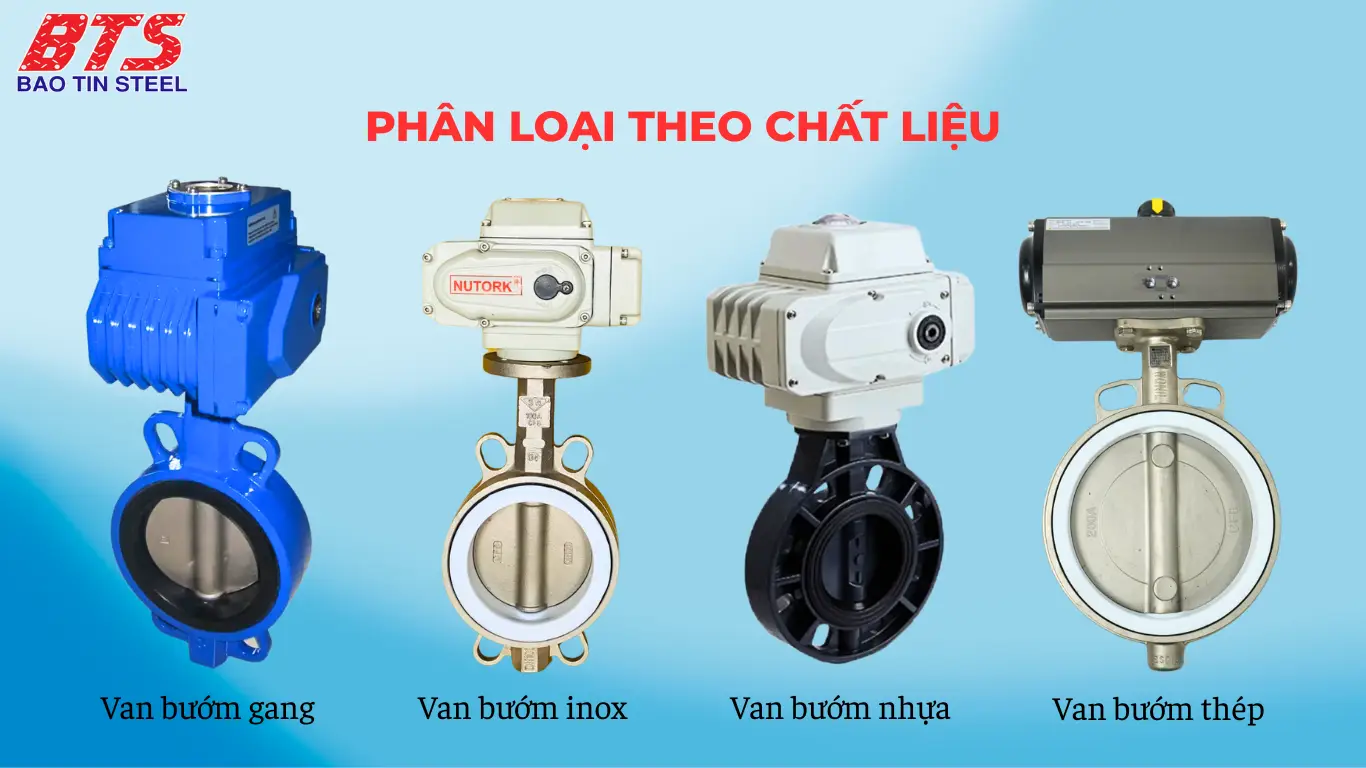
| Type of Butterfly Valve | Key Features | Common Applications |
|---|---|---|
| Van bướm gang (Cast Iron Butterfly Valve) | Affordable, high durability, medium pressure resistance | Clean water, HVAC, fire protection (PCCC) |
| Van bướm inox (Stainless Steel Butterfly Valve) | Excellent corrosion resistance, high durability | Chemicals, food processing, seawater, oil and gas |
| Van bướm nhựa (Plastic Butterfly Valve) | Lightweight, good chemical resistance, cost-effective | Mild chemicals, wastewater treatment |
| Van bướm thép (Carbon Steel Butterfly Valve) | Sturdy, high-pressure and temperature resistance | Oil and gas, heavy industries |
Classification by control mechanism
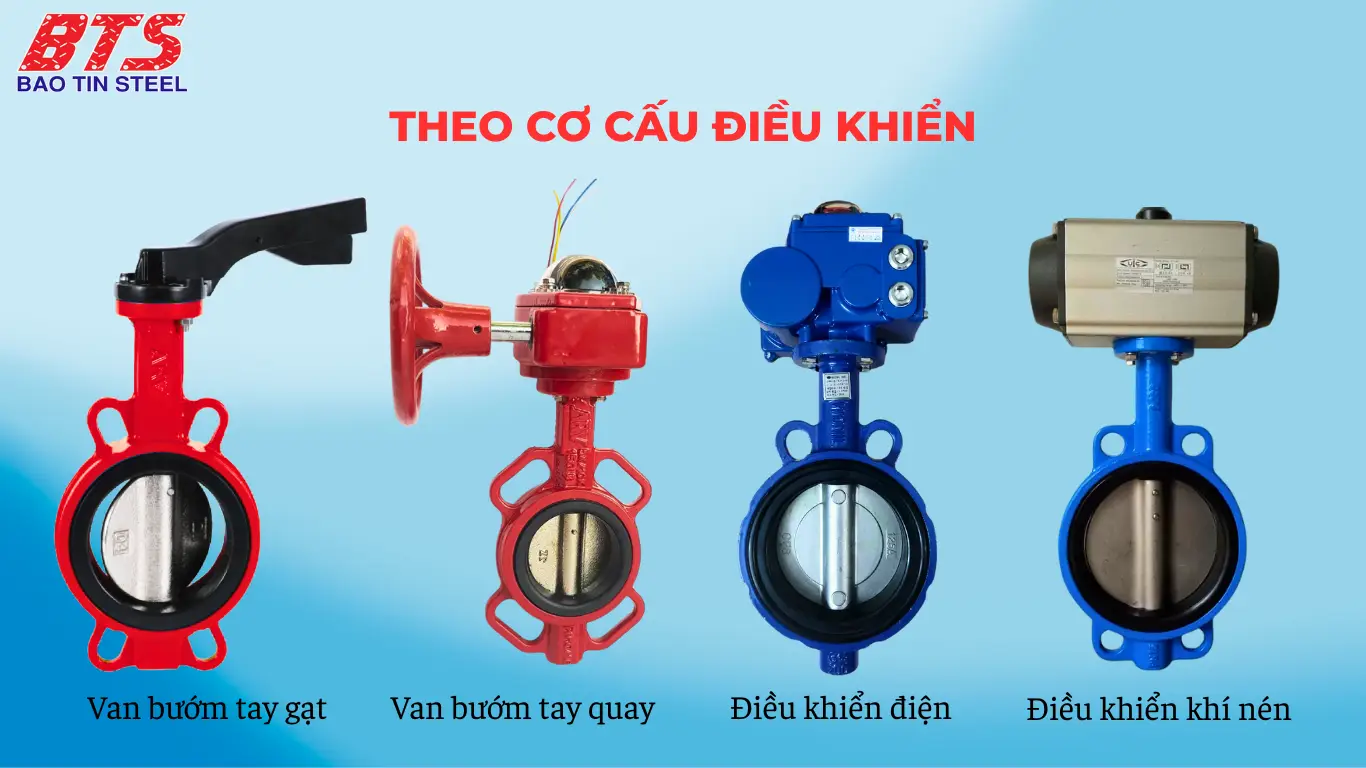
| Actuation Mechanism | Description & Application |
|---|---|
| Tay gạt (Lever) | Fast operation, used for small valves (DN50–DN150), easy to install, cost-effective. |
| Van bướm tay quay (Gear) | Includes a gearbox, lighter operation, used for valves DN200 and above, suitable for larger systems requiring easier manual operation. |
| Điều khiển điện (Electric Control) | Remote control, precise operation, ideal for automation systems where accurate control and remote operation are needed. |
| Điều khiển khí nén (Pneumatic Control) | Fast opening/closing speed, high reliability, commonly used in factories and industrial plants where quick response times are essential. |
Classification by connection type
Connection design affects disassembly, tightness, and initial investment costs. Here are the common connection types:
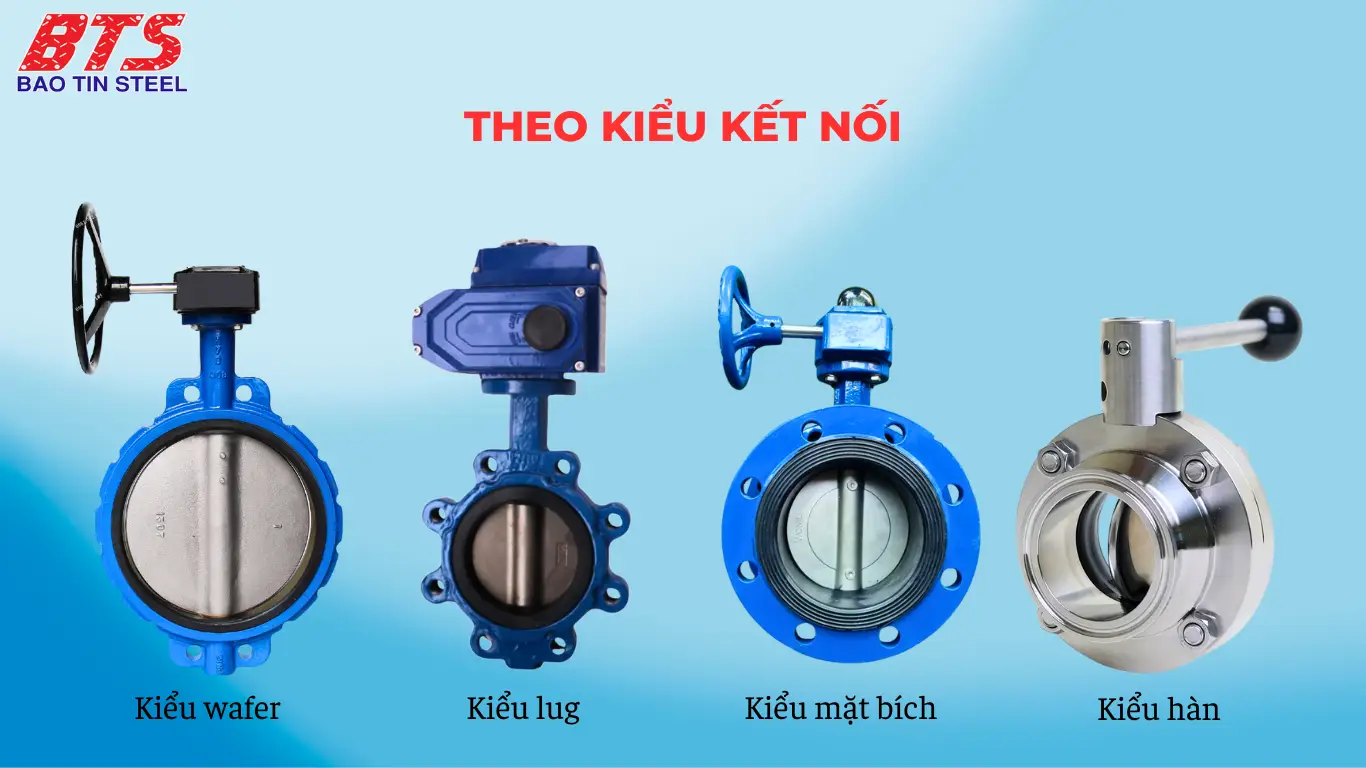
| Connection Type | Advantages & Disadvantages | Applications |
|---|---|---|
| Wafer | Lightweight, easy to install, cost-effective. Disadvantages: May not be as strong as other types for higher pressure systems. | Common in construction, residential, and low-pressure applications. |
| Lug | Threaded lugs for easy, independent disassembly. Disadvantages: May be bulkier than wafer type, but still relatively compact. | Used in medium-sized industrial systems and where one-sided isolation is needed for maintenance. |
| Flanged | Direct bolted connection offers high sealing and strength. Disadvantages: More costly and requires additional space for bolting. | Common in large pipelines and high-pressure systems, such as oil & gas, and heavy industries. |
| Welded | Fixed welding ensures no leakage, highly durable. Disadvantages: Difficult to disassemble and requires specialised equipment for installation. | Used in closed-loop systems, critical applications with low maintenance requirements, like petrochemical plants and nuclear facilities. |
Classification Based on Valve Disc Design:
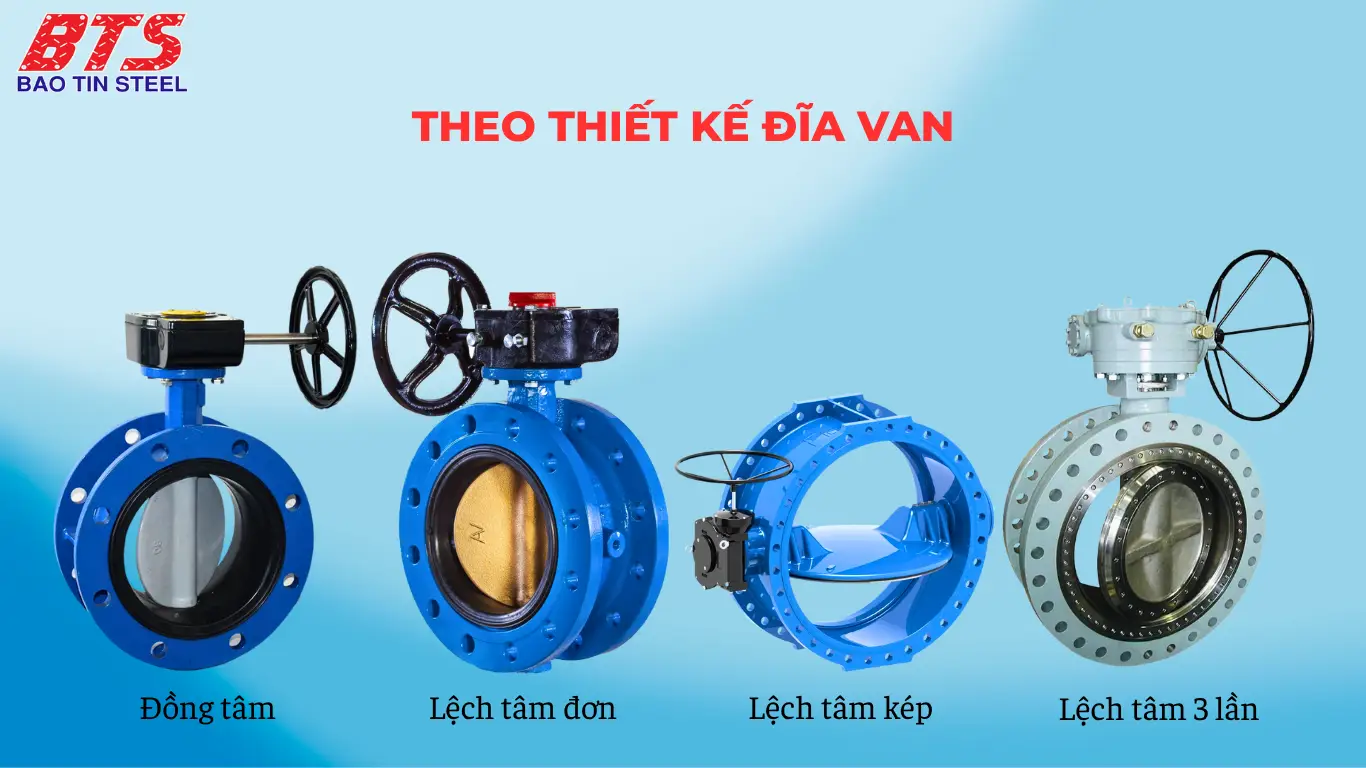
| Disc Design Type | Characteristics & Performance |
|---|---|
| Concentric | The shaft passes through the centre of the disc. Provides moderate sealing, suitable for low-pressure systems. |
| Single Offset | The shaft is offset to the rear, reducing friction and extending gasket life. Ideal for medium pressure applications. |
| Double Offset | The shaft is offset along two axes, improving sealing and flow regulation. Best suited for better control in medium to high-pressure systems. |
| Triple Offset | The disc is offset in three directions, ensuring linear contact with the seat. Provides excellent sealing and is ideal for high-pressure systems and absolute tightness. |
Choosing the right type of butterfly valve according to the intended use will help optimise operational efficiency, prolong system life and save long-term investment costs.
Advantages and Disadvantages of Butterfly Valves
Outstanding advantages
Butterfly valves are popular in many industries due to their numerous advantages in design, performance and cost. Here are the main advantages:
- Compact Design: Butterfly valves are much smaller and lighter compared to ball or gate valves. This results in space-saving during installation and reduces structural costs.
- Quick Opening/Closing: The valve operates by rotating a quarter-turn (90 degrees), providing fast and precise operation, making it ideal for systems that require immediate responses.
- Reasonable Investment Costs: The competitive pricing of butterfly valves saves on installation, operation, and maintenance costs.
- Flexible Flow Regulation: The valve disc can be held at various angles to control flow rates, making it suitable for both on/off and throttling functions.
- Ease of Automation: Butterfly valves are easily automated with electric, pneumatic, or hydraulic actuators, allowing for smooth integration into centralized control systems.
This combination of features makes butterfly valves a cost-effective and efficient choice for a wide range of industrial applications.
Some limitations
Despite the many benefits, butterfly valves also have some limitations that should be considered during the selection process:
- Not Suitable for Very High Pressure: Despite the triple offset design (triple eccentric), butterfly valves are still not ideal for systems that require extremely high pressure, such as globe valves, which are designed for such conditions.
- Sealing Performance Not as Good as Ball Valves: In applications that demand absolute sealing, butterfly valves may not provide the same level of tightness as ball valves, especially if used for extended periods or if incompatible gasket materials are used.
- Potential Flow Disruption: The disc is located within the pipe, and even when fully open, it can still disrupt the flow, especially in systems with high flow velocities or where flow sensitivity is critical.
These limitations are important to consider when choosing a butterfly valve for specific applications, particularly where extreme pressure, sealing, or flow consistency is a priority.
Butterfly valves are best suited to systems that require quick action, low cost, limited space, and good regulation at moderate pressures. If absolute tightness or high-pressure operation is required, careful consideration should be given to design and materials.
How to choose the right butterfly valve
Choosing the right butterfly valve not only helps the system operate efficiently but also increases equipment life, saves maintenance costs and reduces the risk of leakage and damage. Below are important criteria to consider when choosing to buy a butterfly valve:
Determine the fluid environment
| Factors to Consider | Selection Suggestions |
|---|---|
| What is the fluid? | Water, wastewater, compressed air, chemicals, food products, etc. |
| Corrosive nature of the fluid? | If corrosive, choose materials like stainless steel (Inox) or PTFE for better resistance. |
| Temperature – Pressure? | – Below 80°C: Use EPDM gasket material. |
Select the appropriate valve material
| Component | Material Suggestions Based on Application |
|---|---|
| Valve Body ( | – Ductile Iron: For fire protection (PCCC), clean water systems. |
| – Stainless Steel (Inox): For chemicals, food processing, and corrosive environments. | |
| Valve Disc | – Coated Ductile Iron: For general applications. |
| – Stainless Steel (304/316): For environments exposed to chemicals or corrosive materials. | |
| Sealing Gasket | – EPDM, NBR: Suitable for water applications. |
| – PTFE: Ideal for chemical-resistant applications. | |
| – Metallic Gaskets: Best for high-temperature environments. |
Connection type suitable for piping system
| Connection Type | When to Use (Khi nào nên dùng) |
|---|---|
| Wafer | Small systems, low cost, quick installation. |
| Lug | When one side needs to be disassembled without affecting the entire system. |
| Flanged | High sealing requirements, large pressure, and large pipelines. |
| Welded | Fully sealed systems, no need for regular disassembly. |
Appropriate control method
| Control Type | Suitable Applications |
|---|---|
| Lever | Small valves, no precise flow regulation required. |
| Gear | Large valves help with easier opening and closing. |
| Electric Actuator | Automation, remote control, smart systems. |
| Pneumatic Actuator | Factories, industrial plants, systems requiring quick response times. |
The valve size must match the pipe diameter.
- Select a valve with DN (nominal diameter) that matches the size of the steel pipe
- Pay attention to the flange connection standard (JIS, ANSI, BS…) to avoid errors in installation
Technical standards & certifications
- Prioritise products that meet international standards such as ISO, ANSI, DIN, JIS, and come with full CO (Certificate of Origin), CQ (Certificate of Quality), technical documentation, and clear warranty terms.
If you’re still unsure about which type to choose, feel free to send us information about the operating environment, pipe size, and technical requirements. Bao Tin Steel will provide advice and suggest the most optimal solution for your system.
Practical applications of butterfly valves
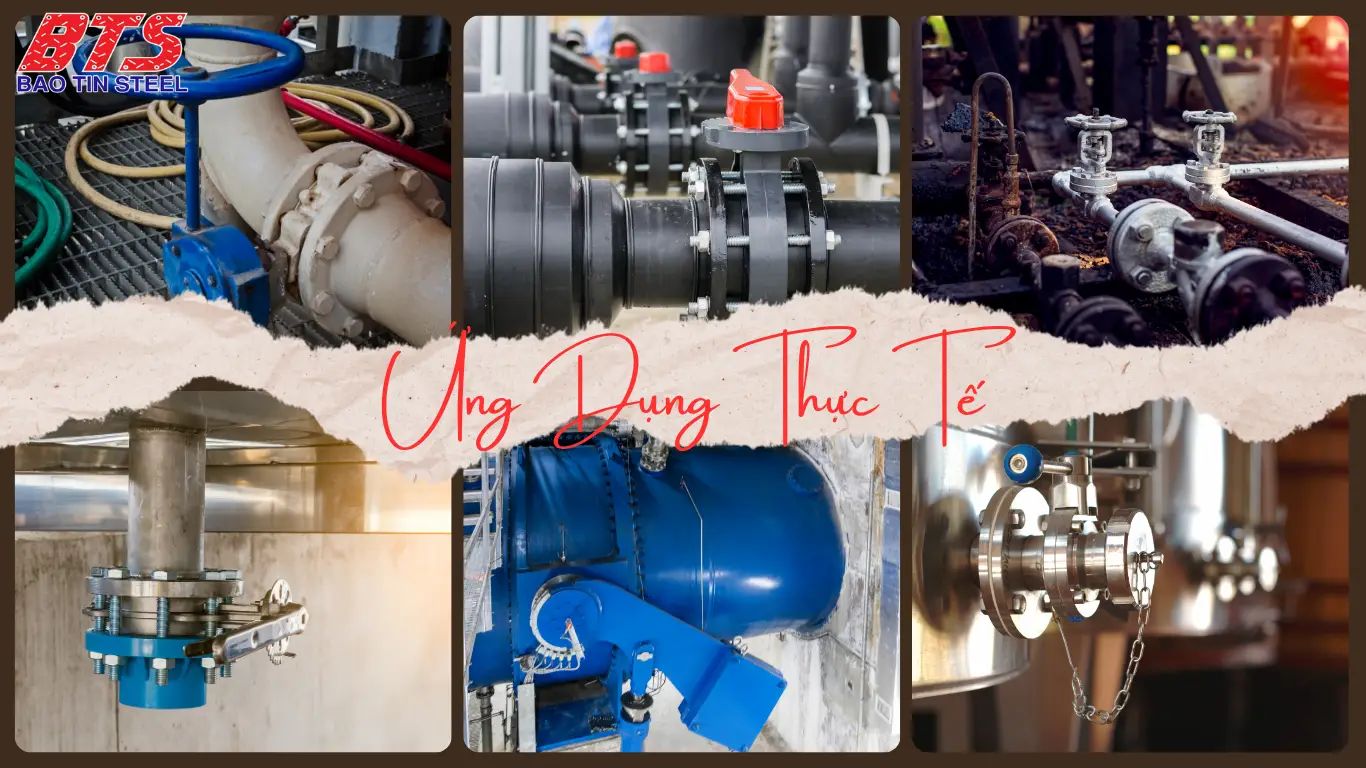
With flexible design, easy control and high cost efficiency, butterfly valves are widely used in many different industries. From civil systems to heavy industrial scale, butterfly valves always play an important role as regulating and opening devices in the pipeline system operation chain.
Fire Protection Systems (PCCC):
-
Valve Type: Ductile Iron Butterfly Valve
-
Seal: EPDM
-
Connection: Wafer or Flanged
HVAC Systems (Air Conditioning and Ventilation):
-
Valve Type: Particularly the wafer type, highly popular in high-rise buildings.
Water and Wastewater Treatment:
-
Valve Type: Ductile Iron or Stainless Steel (304/316), depending on the fluid and corrosion level.
Chemical Industry:
-
Valve Type: Stainless Steel Butterfly Valve or PTFE-lined Body, combined with electric or pneumatic control, commonly used for transporting acids, alkalis, or hazardous chemicals.
Food and Pharmaceutical Industry:
-
Valve Type: Sanitary Butterfly Valve, made of Stainless Steel 316L with a high-quality polished surface, used for transporting purified water, milk, beer, fruit juices, etc.
Oil and Gas, Energy Industry:
-
-
Valve Type: Double or Triple Offset Butterfly Valve to ensure absolute sealing and high pressure resistance.
-
Butterfly valve installation & maintenance guide
Proper installation and maintenance will ensure reliable operation of the butterfly valve, increase its lifespan and reduce the risk of damage or leakage. Here are some practical guidelines for the technician or contractor:
Butterfly valve installation instructions
Preparation before installation
- Check the valve condition (no warping, cracks, or size deviation).
- Clean the piping and connection surfaces to avoid foreign objects.
- Do not use gaskets between the valve and flange for wafer valves.
Installation steps:
- Step 1: Place the valve in a nearly closed position (the disc opens at a small angle) to avoid damaging the gasket when inserted into the pipeline.
- Step 2: Align the valve shaft horizontally, especially with large valves to limit asymmetrical wear.
- Step 3: Place the valve between the two flanges in the centre, do not deviate.
- Step 4: Tighten the bolts in a star/symmetrical shape, with just enough force; do not tighten too hard to avoid deforming the valve body.
- Step 5: Test the operation of opening/closing the lever or turning the handwheel gently, without jamming.
Operating Instructions
- Open/close by turning the lever or handwheel in the direction of the arrow.
- The valve usually only needs to be rotated 90 degrees to switch from the fully open to the fully closed position.
- Do not operate the valve if the pressure or temperature exceeds the specified limits on the product label.
- For automated control valves, it is recommended to check the power supply signal and ensure stable air pressure before operation.
Regular maintenance & servicing
| Item | Maintenance Guidelines |
|---|---|
| Seal Condition | Replace if worn, cracked, or hardened. |
| Disc and Shaft Surface | Clean thoroughly, avoid buildup or corrosion. |
| Control System (if any) | Check for leaks, motor, power supply, and feedback signals. |
| Test Operation | Operate the valve 1-2 times a month if the system is rarely used to prevent valve jamming. |
| Lubrication | Use specialised grease for the shaft or moving joints (if recommended by the manufacturer). |
Important Note:
- Do not use butterfly valves to close/open fluid lines with floating hard particles (such as mud, coarse sand, etc.).
- Do not use supporting tools (long force, stiff handle) if the valve is stuck – check the cause first.
- For valves that have not been used for a long time, depressurise and check before operating again.
Bao Tin Steel – A reputable supplier of butterfly valves in Vietnam
With over 10 years of experience in the industrial supply sector, Bảo Tín Steel Co., Ltd. has become a trusted partner for thousands of customers both domestically and internationally. We specialise in distributing a wide range of industrial butterfly valves, from standard to high-end models, suitable for various industries such as fire protection systems (PCCC), water supply and drainage, HVAC, chemicals, food processing, and more.
Reasons to choose Bao Tin Steel when buying butterfly valves:
Diverse products – genuine
Bảo Tín Steel – Your Trusted Butterfly Valve Supplier
Product Range:
-
Types of Butterfly Valves: Lever-operated, Gear-operated, Electric and Pneumatic-controlled valves.
-
Materials: Cast Iron, Stainless Steel, Carbon Steel, and Plastic.
-
Connection Types: Wafer, Lug, Flanged, with standards including JIS, BS, ANSI.
Certifications and Quality Assurance:
-
Full certifications with clear origin.
-
CO, CQ, test reports available to meet tender and large-scale project requirements.
-
Direct import from reputable brands like YDK, Shin Yi, ROBO, Wonil, Minh Hòa.
Competitive Pricing & Project Discounts:
-
Best Price Guarantee based on quantity.
-
Quick quotes provided on the same day.
-
Free technical consultation available.
Large Inventory & Fast Delivery:
-
Our warehouses are located in Ho Chi Minh City, Bac Ninh, and Cambodia, ready for immediate shipment from DN50 to DN500+.
-
Nationwide delivery through reliable logistics partners.
Professional After-Sales Service:
-
Clear warranty policies by the manufacturer’s terms.
At Bao Tín Steel, we ensure high-quality products, prompt service, and competitive prices, making us the perfect choice for your industrial valve needs.
Are you looking for a source of genuine butterfly valves, diverse types and fast delivery?
Explore our collection of high-quality butterfly valves at Bao Tin Steel, featuring full CO, CQ certificates. We are always ready to meet all requirements in terms of quantity and progress.
CALL NOW: 0932 059 176 or Request a quick quote here!
Tiger Steel is a subsidiary of Bao Tin Steel.


 Tiếng Việt
Tiếng Việt ភាសាខ្មែរ
ភាសាខ្មែរ